What is the Air Raid Offense?
New Kansas head football coach David Beaty is bringing a new offensive scheme to the Jayhawks, expecting the Air Raid offense to keep defenses on their heels and fans on their toes.
“Offensively, let’s talk about that. Real easy. Fast-paced, up-tempo offense that places high pressure on defenses, things that don’t allow them to communicate with their coaches at the sideline. It’s going to attract top recruits, and it’s going to be an exciting brand of football that’s going to make people want to come to Memorial Stadium.” That’s how Kansas head football coach David Beaty put it when he spoke of the kind of offensive football he and his staff would bring to the University of Kansas football team in his tenure. He was talking about the Air Raid, an offensive scheme with a long history (including a stint at KU under Mark Mangino) and short playbook. It has evolved to a point where the current iterations of the Air Raid are unrecognizable from the early days. The thing that hasn’t changed? Eye-popping passing and receiving statistics from some of the game’s greatest offenses.
History
The Air Raid story starts in Provo, Utah, at Brigham Young University in the late 1980s. Coach LaVell Edwards’s BYU Cougars were racking up wins and collegiate passing records at an astonishing pace with the help of future NFL quarterbacks Steve Young, Jim McMahon, and Ty Detmer. The offense Edwards used was very similar to the West Coast offensive scheme the dominant San Francisco 49ers and legendary coach Bill Walsh used at the time. It utilized crisp timing routes by backs and receivers to put the defense in a bind. Most of the yards from Edwards and Walsh’s schemes were from backs and receivers adding yards after the catch. BYU and Edwards used a trimmed-down version for his college players.
Edwards’s success drew interest from the Valdosta State coaching staff led by Hal Mumme, Mike Leach, and Tony Franklin. They were looking for ways to make their passing game more productive, and Edwards seemed to have had an answer. Mumme, Leach, and company stripped down Edward’s complex scheme into a few core passing concepts and a small handful of running plays. The passing concepts included Mesh, All-Curl, Y-Corner, Y-Stick, All Vertical, and Shallow Cross. They also backed the quarterback up into the shotgun to help the timing of the routes. What followed still reverberates around college football. In its original form, the Air Raid started from a two back (H, F) set with a tight end (Y), similar to most formations teams used at the time. For a detailed version of what Valdosta State and Kentucky ran then, see Valdosta’s playbook from 2000 here.
For our purposes in describing an offense we will see the Jayhawks run this season, we will use a modern, spread version. Kentucky used some spread concepts with the Air Raid starting with Tim Couch in the late 1990s. The spread really took off when Mike Leach became the head coach at Texas Tech University in 2000. He regularly used four wide receivers and wide line splits in order to make the defense defend the entire field horizontally. Notable Red Raiders such as Kliff Kingsbury (now head coach at Texas Tech), Graham Harrell, Michael Crabtree, and Wes Welker put up eye-popping stats for Leach’s high-powered passing attack on the way to a bowl game every season.
Core concepts
Mesh
The Mesh concept is what we traditionally think of when we talk about the Air Raid. It is a concept that has lasted from the original Mumme-Leach days, and Kevin Sumlin at Texas A&M, Dana Holgerson at West Virginia, Art Briles at Baylor and other coaches from the Air Raid tree still run it with great success. The play is simple, and if executed properly, can be deadly against many coverages, even with less-talented athletes. At its core, Mesh seeks to create a rub between the slot receiver Y and flanker X. The mesh point should be so precise as to allow the receivers to slap each other’s hands as they run past each other. The receivers settle in a soft spot versus zone coverage and run to open grass against man coverage. However, the quarterback should not focus strictly on the mesh. If it is there, he should hit Z on the corner route.
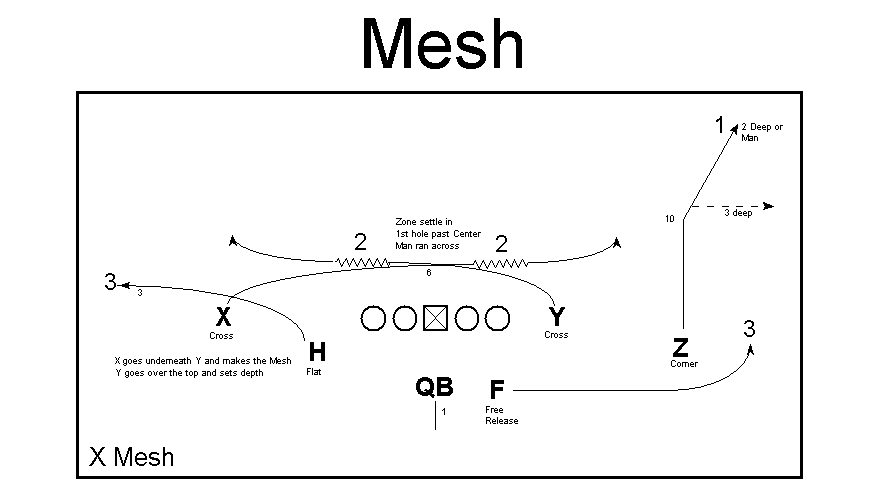
All-Curl
One concept I saw KU run extensively during the spring game was All-Curl. It is as simple as it sounds. Each receiver runs a 5-7 yard curl route. The depth of the route depends on the coverage, down, and distance. If the defense is in press coverage, then the curl will tend to be deeper. Against off-coverage, the curls will be more shallow. The play is an overload concept, meaning that every receiver runs a similar pattern in order to overload the defense. For example, against Cover 3 (three deep defenders) there will only be four defenders playing coverage underneath. In All-Curl, there will be five receivers in the underneath part of the field, meaning one will be open. Like Mesh, it is meant to be a quick hitter with most yards coming after the catch.
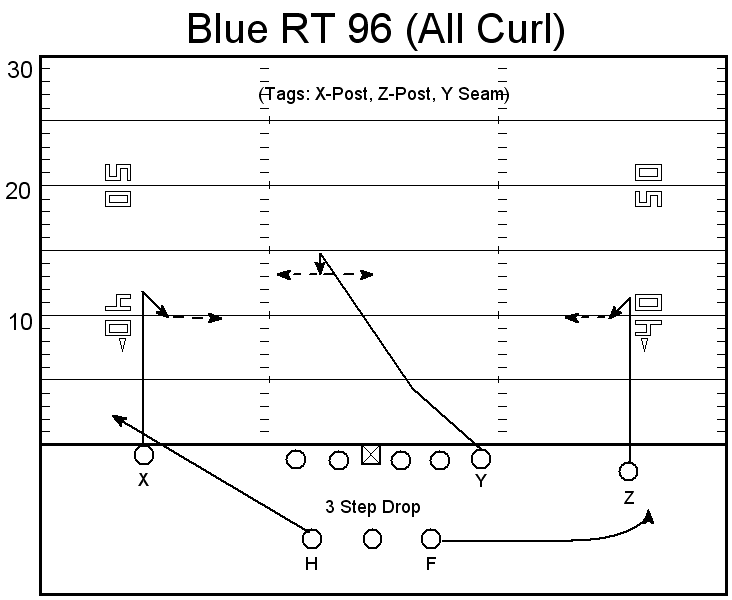
Y Corner
Another staple of the Air Raid is the Y Corner concept. The slot receiver (Y) is the main target of the play. He runs a 10-yard corner or sail route. The other frontside receiver (Z) runs a slant and will either run through coverage against man or settle in a soft spot against zone. On the backside of the play, teams can run Y Corner in a couple different ways. As pictured below, the slot H runs a slant. His route will be deeper than the Z. The flanker (X) can run a slant out, a hitch or a pure slant depending on man, zone, press, or off coverage. This play is very effective in the red zone, as there are built-in adjustments to the play depending on the coverage, and the spacing allows for a shallow or intermediate pass. Pre-snap, the quarterback reads the coverage and will go first to the weak side of the defense.
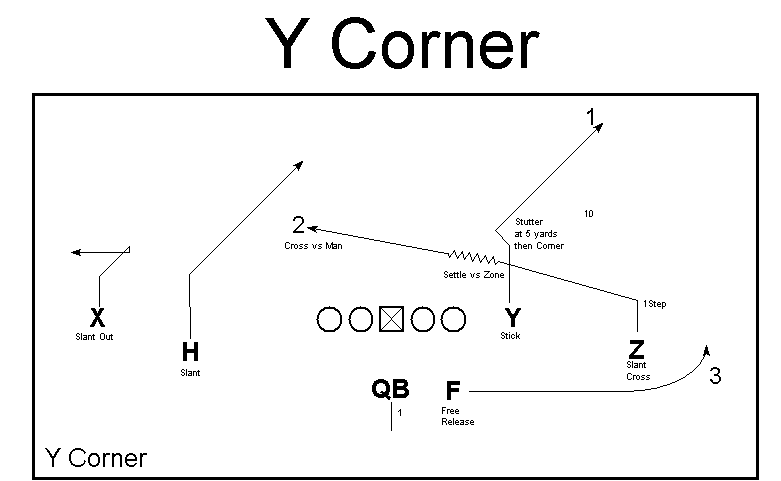
Y Stick
The Y Stick concept is very similar to Y Corner. In fact, the backside read is identical. The frontside is quite different. The play is designed to give the slot receiver (Y) a favorable matchup against man coverage or open space against zone. Z runs a mandatory outside fade to chase off defenders and give Y as much space as possible to work. Y runs 5-7 yards upfield, plants his foot, and turns inside toward the quarterback. Against zone, he will work slowly to the sideline trying to find a soft spot. Against man, he will try to beat his man to the sideline. It is crucial for the quarterback to throw an accurate ball to Y, right at his outside jersey number. This is so he can break upfield and gain yards after the catch.
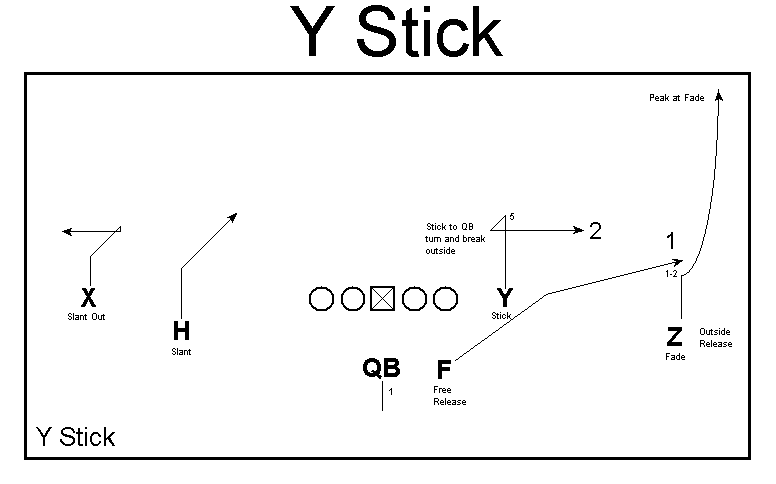
Shallow Cross series
The newest concept we traditionally associate with the Air Raid is the Shallow Cross series. It is a series because there are many, many variations of how Shallow Cross can be run, depending on defensive matchups and the skillsets of the receivers. The Shallow Cross is really built around two routes, the shallow and the “hunt.” The two verticals are simply to occupy defenders and give the other two receivers space to operate. The most important route is the cross. As pictured below, the slot H runs a crossing route several yards upfield. If it’s a good matchup, he can usually outrun his man across the field, come open underneath the coverage, and gain good yards after the catch. The “hunt” route is ran by the slot receiver on the other side of the formation. He will run a ten yard dig or square in route. Against man coverage, he will keep running across the field to the sideline. Against zone, he will find a soft spot and settle. The real strength of this play comes in its versatility. Coaches can tag any receiver to run the crossing route. The backside fade and “hunt” will remain the same. It is a great call against man coverage, especially when one receiver has a clear advantage against a defender he’s matched up against.
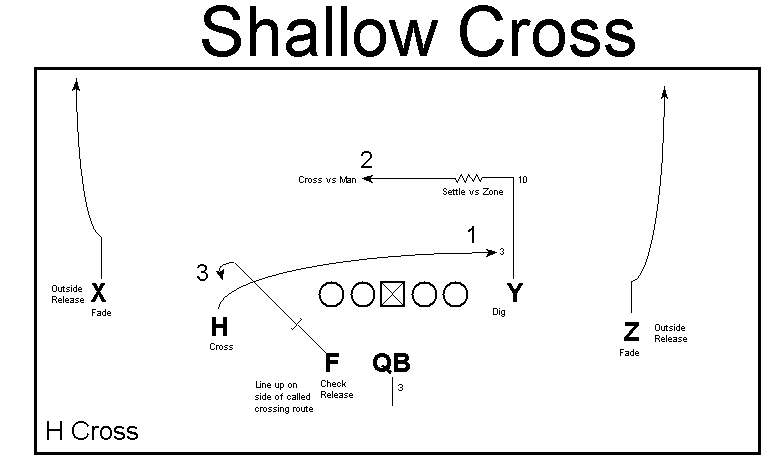
Four Verticals
The newest core Air Raid concept is the All Verticals or Four Verticals concept. It has been around as long as the modern passing game, having been invented by Sid Gillman. At Texas Tech, Mike Leach adapted the concept to the Air Raid and saw the Red Raiders obliterate conference and national passing records. It is a very effective change-of-pace play in contrast to the other concepts, which are more quick-hitters, looking for yards after the catch. Baylor, with Bryce Petty and his host of talented receivers, ran this concept better than anyone else in the country last season. It is certainly an explosive play if executed well.
The “Four Verts” strengths lie in its simplicity and versatility. The Air Raid scheme also places its stamp on the concept. Each receiver has a “landmark” that they are to run at to maintain spacing and put defenders in conflict. Receivers sprint upfield against any coverage for at least 10-15 yards. Against man coverage, especially with one high safety, they will keep running upfield trying to make the defense stretch out and spring one of the receivers open. The inside receivers have freedom to break off their vertical route and run to open grass if the defense allows. Any receiver can settle into a hitch or comeback route if the defense plays off. Against zone, especially Cover 3, this play will tend to overload the defense and spring one receiver for a huge gain.
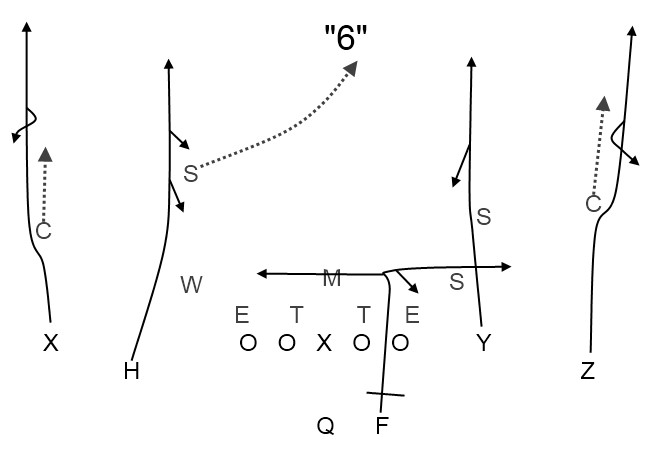
What to expect from the Jayhawks
The Air Raid spread like wildfire throughout college football in the late 2000s and early 2010s. Schools from Washington State to Texas A&M to East Carolina adopted versions of it. Its spread was especially rapid in the Big 12, where seven out of ten schools currently run some version of the Air Raid. Only Kansas State, Iowa State, and Texas run something else. So how will the Jayhawks compete? Look to David Beaty’s former team, Texas A&M, for answers. Kevin Sumlin’s Aggies incorporate several other elements into their Air Raid attack. The most obvious is their up-tempo, no-huddle pace. The Aggies almost never huddle on offense and run the offense at warp speed, so the defense will not have time to substitute fresh players onto the field. Sumlin also runs the ball much more than most Air Raid teams. They strive for close to a 50/50 split in runs and passes. This gives the defense more to watch for once the ball is snapped. A&M also uses much more pre-snap motion than most of their Air Raid predecessors. This allows them to more easily diagnose defensive coverages.
A&M also uses “packaged plays,” a relatively new phenomenon in college football. Packaged plays use run blocking by offensive lineman and with quick routes by receivers to put the defense in a huge conflict. This is because the quarterback has the option to hand the ball off to a running back or throw a quick pass. This could be a talent equalizer for the Jayhawks this season, as packaged plays are effective at creating space for backs and receivers because the defense has to hesitate and wait for the quarterback’s decision before committing to playing the run or pass. See an example of an Air Raid style packaged play here via Grantland. These are several wrinkles Jayhawk football fans should watch for in David Beaty and Rob Likens’ Air Raid this upcoming season.

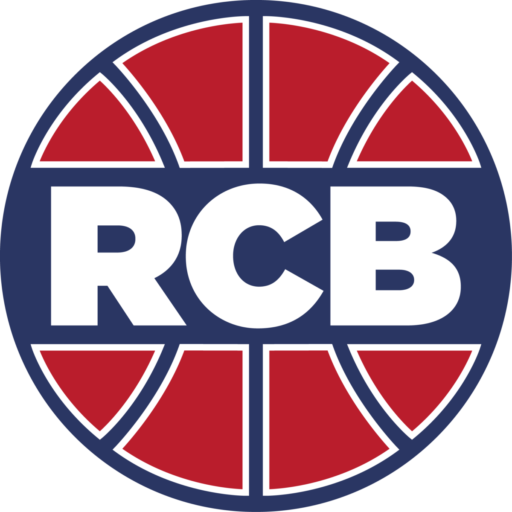

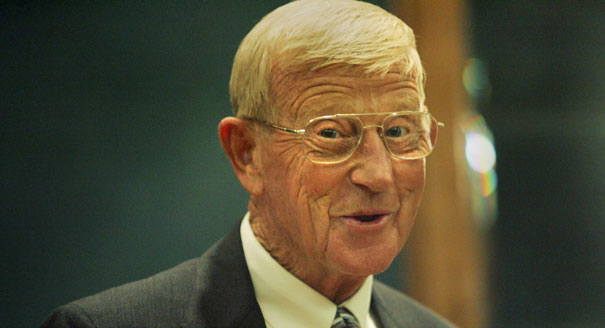
2,717 thoughts on “What is the Air Raid Offense?”